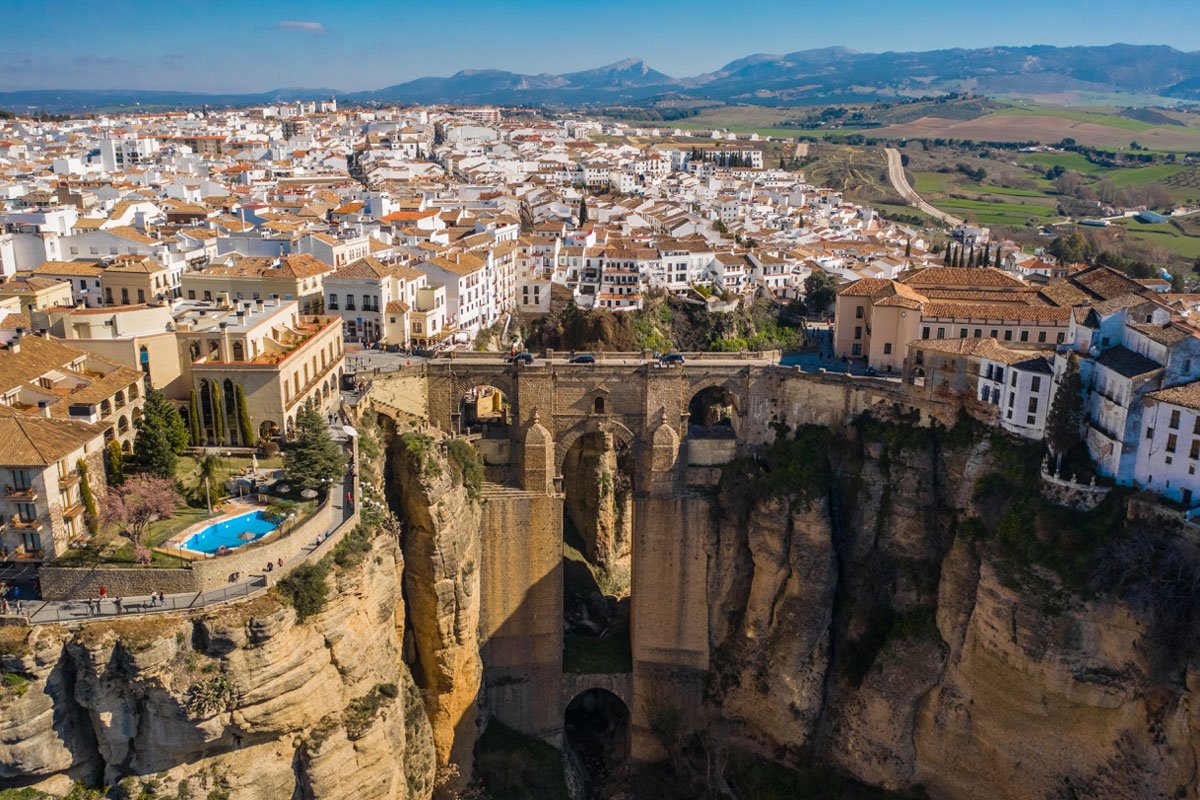Ronda is one of the most impressive Andalusian cities. It is located in the north-west of the province of Málaga. It is the ideal place for a day trip from the Costa del Sol, just 50 km from the coast at the height of San Pedro.
Orson Welles, who later found his resting place here, fell in love with Ronda. Ernest Hemingway, for his part, described his impressions of Ronda as follows: “The whole town, as far as the eye can see, is nothing but a romantic theatrical backdrop”. To this day, a promenade with stunning, panoramic views bears his name: Paseo de Ernest Hemingway. It can be said to be like a phenomenon of the city, which piles up on two massifs of rock about 740m above sea level.
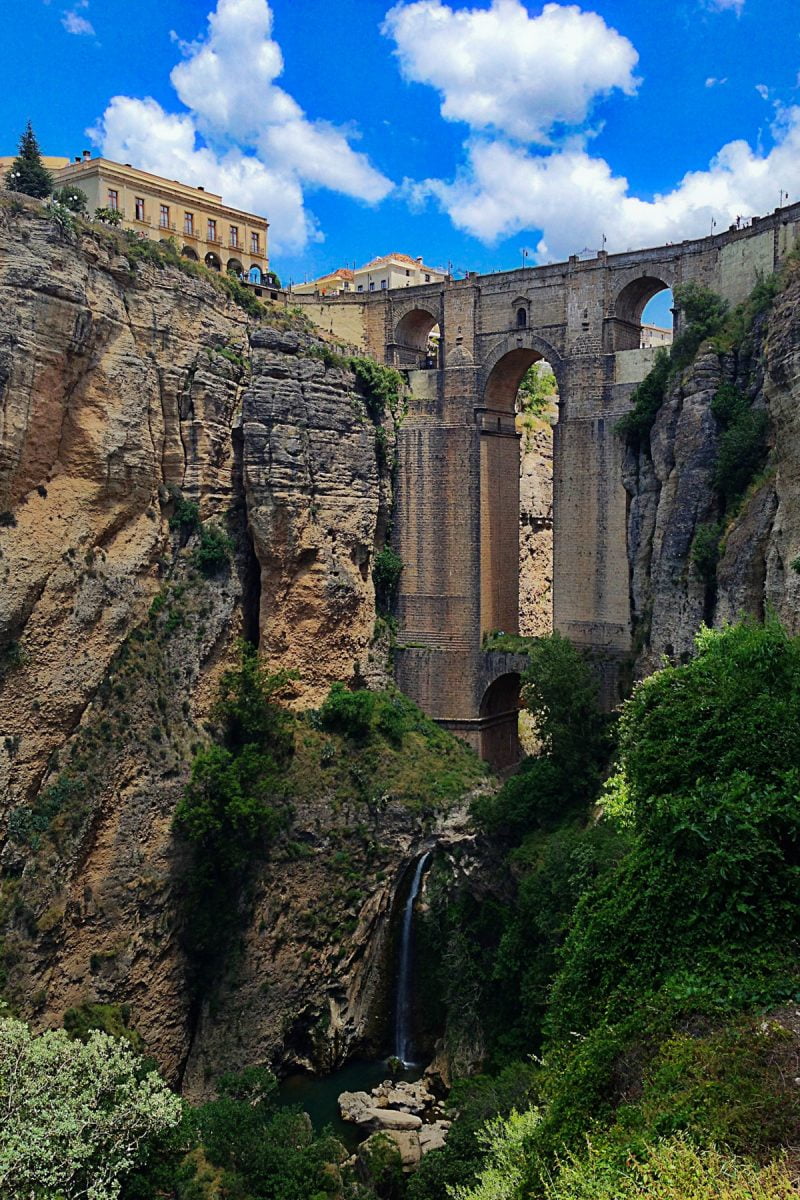
The gorge by the Guadalevín River, whose name derives from Arab times and means river of milk due to the sedimentary colouring of the water, divides the city into the former Moorish quarter and the one founded by Christians, where the bullfighting arena is located. Thanks to its difficult-to-capture location, Ronda boasts a long and turbulent history: from Roman times, through Moorish rule, to the conquest of the city by the Catholic Kings Ferdinand and Isabella in 1485.
Here are our suggestions for activities when visiting Ronda and the surrounding area:
*It is advisable totake comfortable shoes for exploring Ronda.Alsorememberthat it is warmer in Ronda in summer and quite a lot colderinwinterthan onthe coast.
**It is most convenient to park in the underground car park on Avda avenue. Martinez Astein and from there cross Calle Infante street towards the old town.
Plaza de Toros – Arena
It is the oldest surviving and one of the finest bullfighting arenas in Spain. It was built at the end of the 18th century and has the largest diameter of 66 metres, (the standard is 60 metres). The arena is surrounded by two tiers of arcades with Tuscan columns, behind which are covered grandstands capable of holding around 5,000 spectators. It is a special place for lovers of corrida. From Ronda comes Pedro Romero, who created the modern rules of this spectacle, which are still in force today. The corrida in the local plaza de toros was immortalised by the great Spanish painter Francisco de Goya in his engravings. To this day, the only bullfights in this arena take place in September and follow the tradition of Francisco de Goya’s period costumes. During your visit, be sure to enter the bullfighting museum, the equestrian exhibition and the Real Maestranza de Caballería de Ronda history hall. You can also explore the nooks and crannies of the Arena and see where the bulls are selected and where they stay on the day of the corrida.
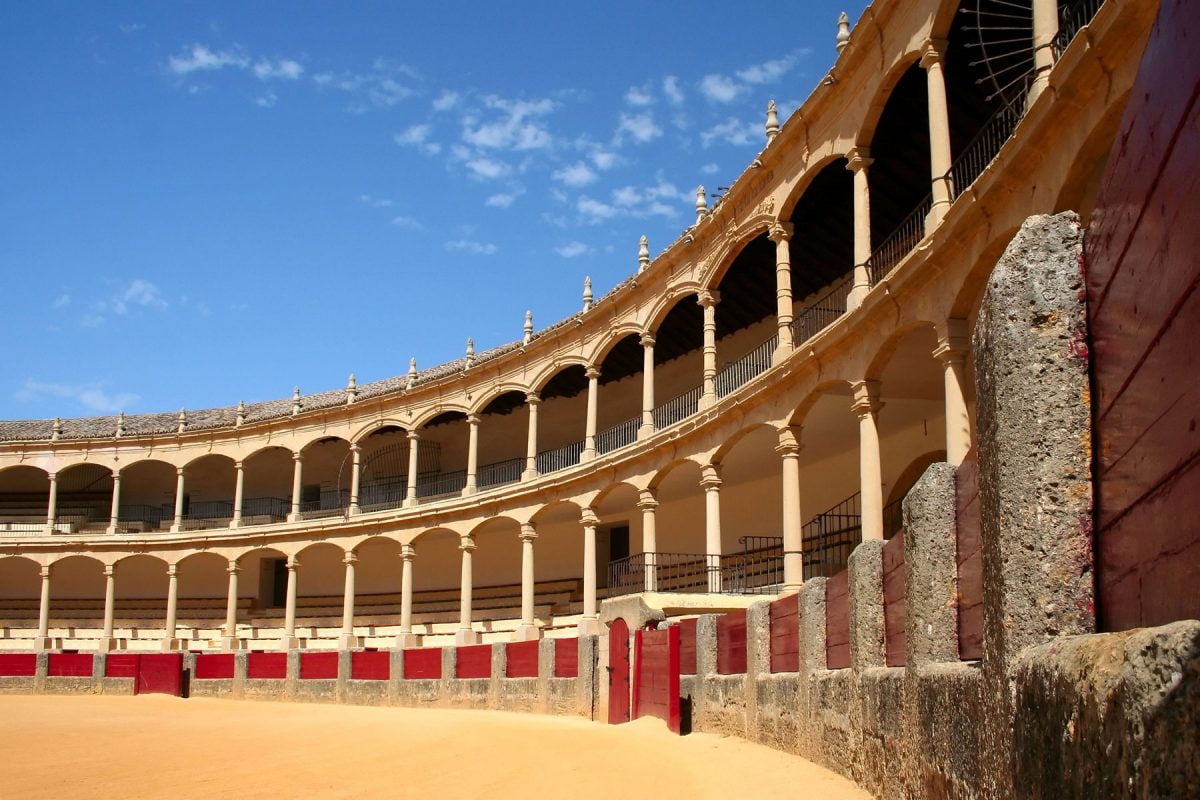
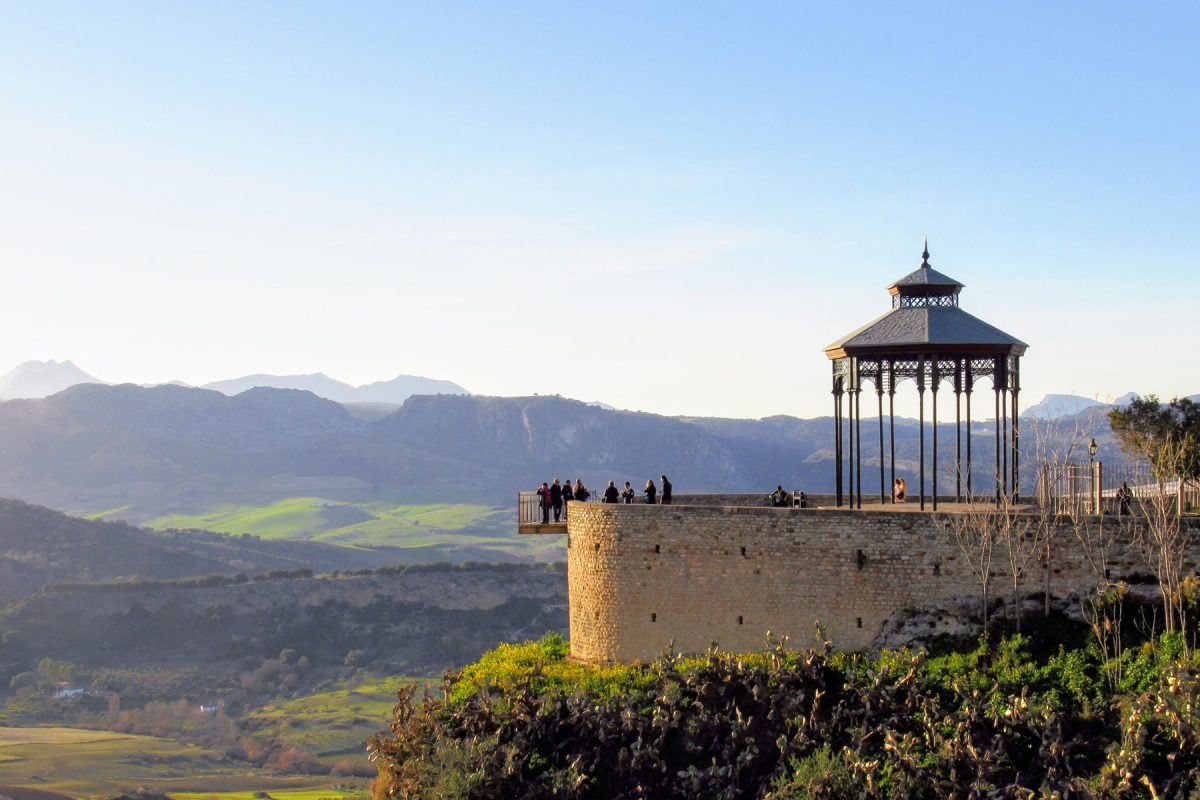
Puente Nuevo – the ‘new’ bridge over the Guadalevín river gorge
It is an outstanding example of 18th-century engineering. Almost 100 metres high, it is formed by massive pillars with a double arch in the middle and one single arch on each side. The bridge was not only used to move residents from one part of the city to another. A window can be seen above the upper central arch. The room built into the structure reinforces the structure of the bridge and once acted as a prison from which escape was impossible.
Palacio Mondragon – 16th century nobleman’s palace.
It is a beautiful and architecturally very interesting noble palace in the mudéjar style, a Christian and Moorish architectural mix. According to legend, the Moorish king Abbel Malik resided here. Inside, you can admire the unique architecture, as well as the collections of Ronda’s historical and archaeological museum.
www.andalucia.org/en/ronda-cultural-tourism-ronda-municipal-museum-mondragon-palace
Casa Don Bosco – a typical Andalusian manor house
If you want to see a typical Andalusian house with an inner courtyard and a small but charming garden, Casa Don Bosco is well worth a visit . In the garden you will find a small balcony from which you can enjoy amazing views of the ravine and the bridge.
Santa Maria la Mayor – Church of the Blessed Virgin Mary
There used to be a mosque on the site of the present church. We enter it through the former minaret(the tower of the mosque fromwhich the muezzin called the faithful to prayer) and on the left we see the formerhorseshoe arch of the mihrab from Moorish times(a mihrab is a niche in the prayer hall; it points in the direction of Mecca where the faithfulshould pray). The façade of the church, built after the earthquake that hit the city in 1580, is unusual. It is decorated with high arches in the lower storey and a two-storey loggia above. The church was built in Gothic style at the end of the 15th century, but was rebuilt in Renaissance style after the earthquake. This is evident in the vaulting. At its central point you will discover a beautiful choir. According to Spanish tradition in cathedrals and important churches, the choir is located between the main entrance and the altar. Worthy of note is the majestic main altar, whose canopy is made of red Camadian pine. The beautiful sacristy is also worth a look.
www.colegiataronda.com/index.php/en/visita-cultural-uk
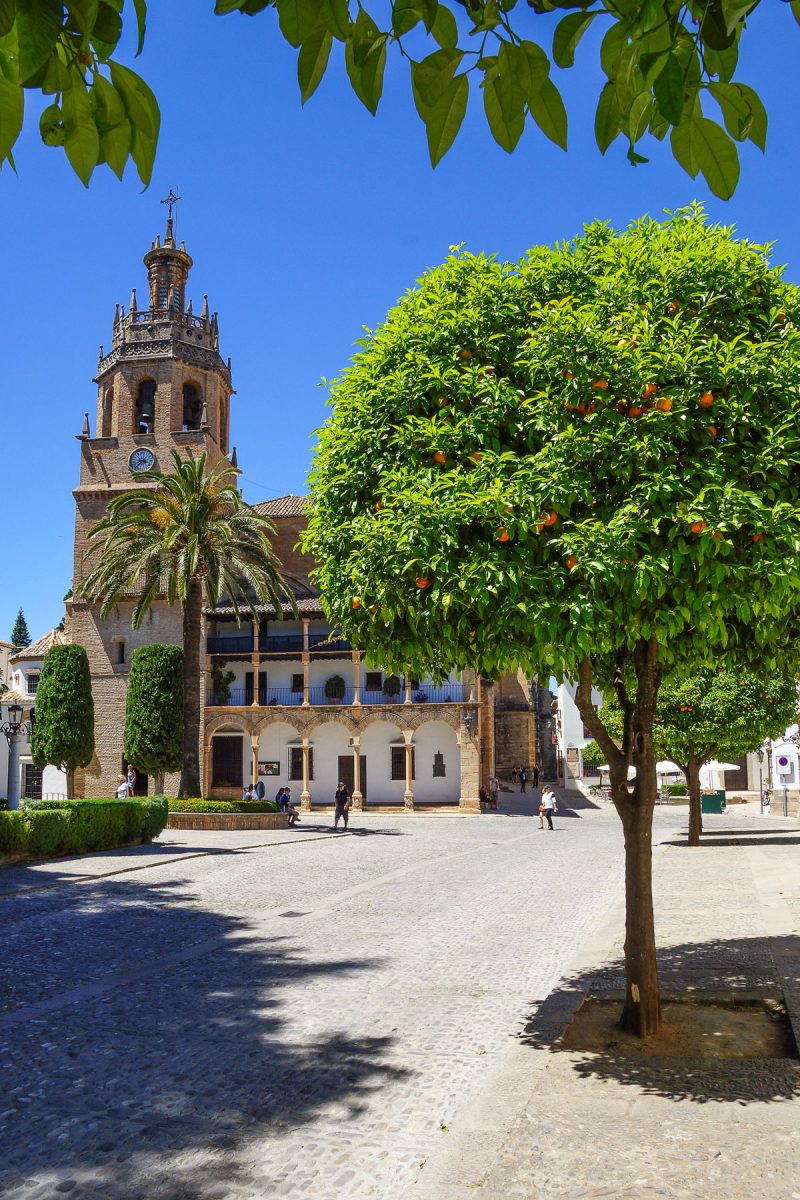
The streets of Ronda, as well as the square in front of the church, are decorated with orange trees. At the end of March and the beginning of April, when they blossom, there is an amazing fragrance in the air. In December, the fruit ripens and makes a beautiful decoration for the following months. They are bitter oranges, which is why no one picks them. They can be recognised by their leaves – they have small bracts. Bitter Oranges were brought to the Iberian Peninsula by the Moors.
Puente Viejo – old bridge
It is also worth going down to the old bridge, which dates back to Arab times and was later rebuilt by Christians. From there you will see sensational views of the city from a different perspective. On the other side of the bridge, you can walk through the gardens up towards the new bridge, admiring the enchanting surroundings.
Catering attractions
Adjacent to the arena is the Catalonia Ronda Hotel, which has a bar on the top floor with breathtaking views of the arena and the mountains. It’s worth popping in here for a coffee or wine.
www.cataloniahotels.com/es/hotel/catalonia-ronda
We recommend enjoying tapas and local specialities at la Taberna bar in the Plaza de Socorro. While in Ronda, you must try the bull’s tail (rabo de toro) or the pig’s cheek dish(carrillada de cerdo). The bar is very popular with locals, so you definitely need to arrive before 2pm to find a seat. A cool local flavour.
If you fancy dining in a typical restaurant with posters and photographs of bullfighters and bull heads on the walls, it is worth going to the Pedro Romero restaurant just opposite the arena. The speciality is, of course, the bull tail. It is certainly an interesting local attraction.
Descalzos Viejos winery
The entire Descalzos Viejos estate covers an area of 16 hectares. It is surrounded by the beautiful Guadalevin River gorge and borders three natural parks. At the top end is the winery, which is housed in a 16th-century Trinitarian monastery. At the back of the building is a beautiful garden with fruit trees and a water spring. The vineyard is situated in the lower part of the property, among old olive trees and Mediterranean oaks. It is a family-run and charming vineyard. We recommend a tour offered by the owners, ending of course with a tasting. Advance booking is necessary.
Reserva Tauro – Spanish bull breeding farm
If you fancy a fully Andalusian experience, it’s well worth a trip to this charming bull farm. The farm is also home to Andalusian horses. Its owner is the former toreador Rafael Tejada. The tour is guided. It is about a 10-minute drive from Ronda. Advance booking is necessary.
Setenil de las Bodegas – pueblo blanco – white village
Another option for spending a day in the area is to visit Setenil de las Bodegas, a picturesque white town 18km from Ronda, but already located in the province of Cadiz. Apart from its beautiful location in the Trejo river canyon, the town has this unique difference from other white villages: Most of the houses were built in rock niches, making Setenil one of the most original towns in Spain. The whitewashed lime facades of the houses, characteristic of pueblos blancos, have been pasted under a large rock shelf. It is worth starting your tour from here, in the morning and enjoying the sunshine in one of the local bars with a coffee. It is best to park your car on the side of the road. In the centre, parking can be problematic due to the very narrow streets.
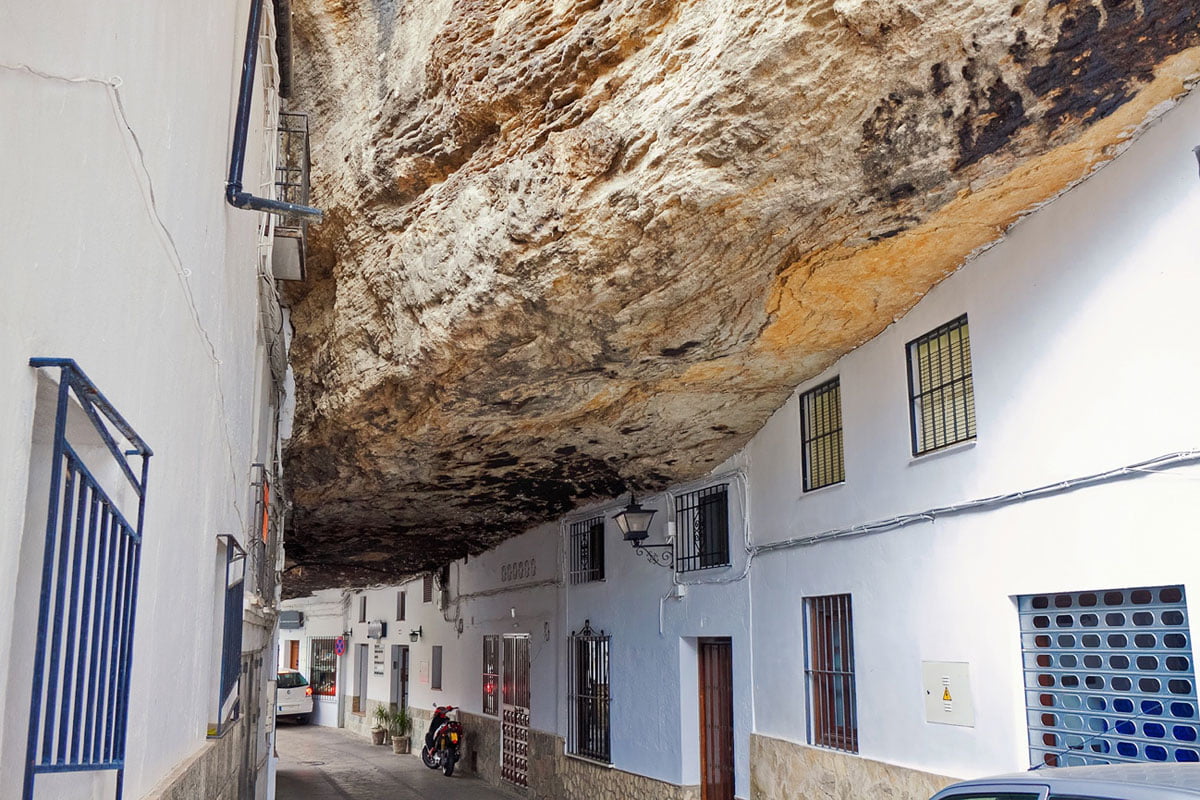
Setenil de las Bodegas is no longer an unknown destination as it was just a few years ago. This town of the province of Cadiz appears in most classifications of the most beautiful towns in Andalusia and even in the whole of Spain. This fame has not taken away its charm. Thanks to its peculiar urban structure, in which rocks are the protagonists, walking through its streets is a pleasure. I absolutely recommend visiting it.
Setenil is one of the destinations of the ‘white villages of Cadiz’ route. Its history is so interesting that it is even reflected in its name: Setenil comes from the Latin Septem Nihil, meaning ‘seven times nothing’, and refers to how hard the Christians had to fight to reclaim these lands. They tried to take the city, besieging it seven times and nothing! Only the eighth attempt, on 21 September 1484, was successful and it was taken over by the Catholic Kings.
Park your car in the upper part of the town on the main road and from there you will have a beautiful panoramic view of the town – Setenil is one of the most unique places in Andalusia. The town is built around a canyon formed by the erosion of the Trejo river, even some of its streets literally wind under the rock.
What to visit in Setenil de las Bodegas:
- In Setenil, all the streets lead to Calle Cueva del Sol, which is certainly the most photographed rock-sheltered street in town. Here you will find a huge rock that protects everyone passing under it from the summer heat.
- Not only is this street exceptionally beautiful, but some of the best bars and restaurants in the city are concentrated here. I recommend Bar Frasquito for a morning coffee or tapas lunch. Try the croquettes (croquetas), fillet (lomo), artichokes with prawns (alcachofas con gambas), stuffed aubergine (berenjena estofada). But these are just a few examples – everything tastes delicious in home bar cuisine.
- Crossing a small bridge over the river, you will enter Calle Cueva de la Sombra, another of the most photogenic corners of Setenil. If the previous street had a rock canopy, here it completely surrounds it, creating very distinctive caves on both sides of the street. There are several bars, craft and souvenir shops. Certainly having a glass of wine under a rocky sky is something you can’t do every day.
- Less touristic than Calles de la Cueva del Sol and de la Sombra are Calles Herrerías, Minas, Calcetas, which, like the former, offer a unique urban layout, sharing a rocky roof.
- You can enjoy Setenil not only by strolling through its interesting streets, but from a vantage point you will have a much broader perspective of the peculiar structure of the city. The best one is the Mirador del Carmen (next to the Nuestra Señora Del Carmen chapel), which is reached after climbing some 90 steps. Calle Cantarería Alta also offers great views of the white town as well as the Church of the Incarnation and the castle on top of the rock.
- Not far from here you will come across a very photogenic Moorish-style door. They are located at Calle San Benito number 13, although the sign you will see will say ‘House 112’ (it is actually 11 + 2 to avoid the number 13 – Andalusians are very superstitious).
- There is a little corner in the town that you cannot miss. Calle Vega, which has a plaque surrounded by blue pots that reads ‘Bésame en Este Rincón‘ – kiss me in this corner, will be ideal if you are going on a romantic trip.
- In the highest part of the town, overlooking a sea of white houses, you can see the remains of the former Moorish fortress from the late 12th century, the defence tower and the cistern where rainwater was collected to power the castle. For a small donation you can climb the tower. Next door is the Church of the Virgin Mary of the Incarnation, which was built on the city’s old mosque in the late Gothic style and under the patronage of the Catholic Monarchs in the late 15th and early 16th centuries. Inside, there is a crucified Christ from the early 17th century, a silk-and-gold chasuble donated by the Catholic Monarchs at the consecration of the building and an interesting painting above the altar from the late 15th century.
- Plaza Andalucía is another place to visit in Setenil de las Bodegas. Here you will find a good atmosphere, bars and restaurants where you can enjoy a cold beer(una caña, por favor – a small beer, please).

